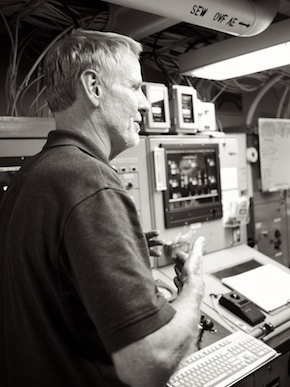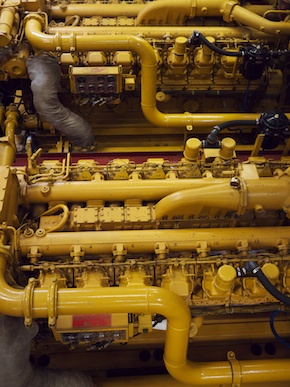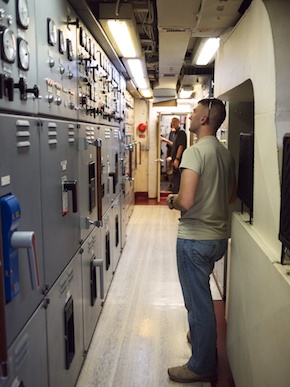The R/V Thomas G. Thompson left Honolulu on November 5, 2011 heading toward the Western Pacific. This expedition journal was written by cruise participants and uploaded about once per weekday, depending on internet availability.
December 9, 2011: The TGT, Righty-tighty and Lefty-loosey

Terry explains everything (Credit: Will Koeppen)
Being a part of the engine department of a ship involves quite a bit more than just knowing which way to turn a wrench. After being greatly intrigued by Brian during our discussion of a few of the engineering aspects of the R/V Thompson, my curiosity took me to meet with the Chief Engineer, Terry Anderson, hoping I could get to know who and what makes the ship run. Because of needlegunning going on near Terry’s office (which is also his stateroom), we met in the main control room. It was here, a mere five feet away from the loudest area of the ship, that I learned a great deal more about what makes the Thompson tick.
Terry explained to me what it means to be a part of the engine department. The Thompson has eight such personnel who are either licensed engineers or Qualified Members of the Engine Department (QMEDs, also known as oilers). They are responsible for just about everything mechanical or machine-related on the ship including waste management, propulsion, electricity, and fresh water production. From here we explored the finer points of each area.
We discussed how waste is dealt with, starting with what happens when we flush the toilet. Our toilets are vacuum-powered, similar to those you find on airplanes. Waste is collected in the Marine Sanitation Device where it is macerated. The device’s chopper pump reduces sewage to a fine puree that is treated with chlorine and emptied from the sewage holding tanks daily. Trash such as metals and some plastics are compacted and stored for recycling or disposal on land, while other waste, such as paper and plastic wrappers, is hauled off to the onboard incinerator that turns what would be mounds of trash into piles of ash.

Big one and two (Credit: Will Koeppen)
Moving our way to “cleaner” topics, we discussed the all-important presence of power generation systems for both propulsion and electricity. The Thompson is currently set up with six diesel engines, each paired with its own generator. We have three 1500kW generators that operate mainly for propulsion and three 750kW generators that provide supplemental power. This setup allows the engine department to cycle through the engine-generators to run them evenly as well as vary the combinations to meet the demands of the mission at hand. For example, when we run TowCam and Sentry operations we travel at 1.5 knots, require one large and one small engine, and consume ~1500 gallons of fuel per day. While transiting we travel at 12–14 knots, require two large and two small engines, and burn ~2500 gallons per day.
The Thompson is not outfitted with conventional drives, which are designed with a straight drive shaft connecting the motor to the propeller. Instead, this vessel has two Z-drives, named for a general Z shape in their drive shafts: the Z-drive shaft extends aft from the motor, makes a 90º bend down through the hull, and another 90º bend to the propeller. This design allows each propeller to pivot 360º independent from one another. When used in conjunction with the 360º turning bow thruster (which uses a centrifugal water jet), the Z-drives grant the Thompson precision maneuverability. For instance, they allows us to use dynamic positioning so the ship can stay in a fixed position without anchoring. The Thompson can also change direction faster than other ships and even drive sideways or backwards if necessary. This is especially useful during scientific operations. For example, current and wave conditions often force us to drive backwards to maintain a safe angle on the TowCam cable, which is suspended from the starboard side boom.
The electricity generated from the engine-generators is also used to provide us with a great many “creature comforts” during our stay aboard the Thompson. A couple of these, specifically air-conditioning and hot water, are run off the supplemental power grid. The majority of the ship’s rooms and passageways are kept cool via air-water heat exchange. Air handlers located at various spots throughout the ship intake ambient room-temperature air and pass it over pipes that have 45º F water running through them. This lowers the temperature of the air, which is then expelled through blowers to make some residents resort to wearing layers of warm clothes in the lab.

Controls (Credit: Will Koeppen)
A more vital use of the supplemental power is to produce our fresh water from seawater. First, seawater is passed through a strain basket filter to remove any large particulates like seaweed. From there it goes through a reverse gradient filter, which removes smaller particulates such as plankton. During this process, the water enters the top of a reinforced fiberglass filter tank and passes down through several layers of gravel that get smaller in grain size until it reaches a sand layer at the bottom. At the end of the reverse gradient, it is pushed through a paper cartridge filter to remove contaminants as small as five microns. At this point, the fluid is very clean saltwater. The saltwater is then pressurized up to ~775psi and forced through a reverse osmosis membrane, which removes salt from a portion of the water and concentrates it in a brine. The brine is discarded and the pure water is then ready to be pumped up to any water fountain or sink that is calling for its presence.
With all of these engineering wonders making our work at sea possible, it comes as no surprise that the members of the engine department are constantly performing preventive maintenance checks and services. The other reason to keep up the maintenance is to keep the Thompson, one of the three global class vessels in the University-National Oceanographic Laboratory System (UNOLS) fleet, from being stuck in the shipyard for more time than necessary. Every five years, the ship is inspected by the American Bureau of Shipping, and as the ship gets older the inspections become more in depth to ensure its structural and mechanical integrity is intact. When the Thompson turned 20, it underwent an inspection where a hole was cut in the hull in order to remove the generators for their first refit since installation. Once the refit was complete and all other inspections passed, the hull piece was welded back into place, stress tested, coated with paint, and sealed so the Thompson could return to work.
The most important message I learned from Terry, however, came not from factual information in regards to what makes the ship run, but instead about who makes it run. He told me it was the great men and women of the crew that keep the ship going. I must say that I have to agree with Terry on that, for we truly are in good hands. ♦
